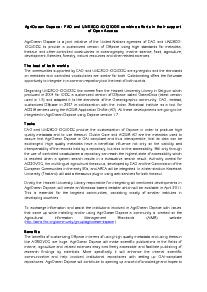
AgriDrupal : repository management integrated into a content management system
Pesce, Valeria and Subirats-Coll, Imma and Picarella, Antonella and Keizer, Johannes AgriDrupal : repository management integrated into a content management system., 2011 . In Open Repositories 2011, Austin (US), 8-10 June 2011. [Conference poster]
One of the main obstacles towards a more efficient management and sharing of agricultural knowledge is the lack of good standard-compliant tools whose adoption and maintenance is really sustainable. In particular, in the implementation of repositories, agricultural Institutions have often faced some common issues in the selection of appropriate software tools, like the need to integrate a repository search and browse interface with their website, the need to implement custom content models, or custom metadata models, and the need to be able to exchange information with other systems and participate in networks.
The proposed poster will describe AgriDrupal, a “suite of solutions” for agricultural information management and dissemination, with special functionalities for repository management, built on the Drupal Content Management System. These solutions are provided, discussed and tested by different Institutions and individuals who are sharing their experiences in the AgriDrupal community.
Besides being available as modular solutions for Drupal, AgriDrupal can also be delivered as a full-fledged information management and dissemination tool putting together the best solutions implemented by the members of the community. This tool can be considered a “reference demo package”, it is not a software tool that the community maintains or gives assistance for: it is a normal Drupal installation with a customized configuration and special modules, and support for Drupal and its modules can be found directly in the Drupal community. This is one of the reasons why AgriDrupal is a sustainable project.
Indeed the focus of the project is on sustainability: beside minimizing maintenance issues by leaving the bulk of maintenance to the community of Drupal developers, the adoption of AgriDrupal does not involve writing code in house or contracting a company, it leverages the open source approach and the wide community behind the tool, therefore benefitting from continuous improvements and upgrades to the latest technological developments. In addition, the features are not just developed ad hoc: the tool allows to handle all common needs of information management and is easily customizable to specific needs: the definition of metadata models, display criteria and browse/search functionalities can be done through an administration panel, and consequently it doesn’t require highly skilled IT capacities.
The AgriDrupal reference tool has advanced features for managing open access repositories in compliance with widely adopted library standards and the OAI-PMH protocol.
The document repository features include: a) a cataloguing interface that out of the box provides the most commonly used metadata elements in bibliographic databases, in particular those defined by the Agris Application Profile , but is easily extendable to include any other element; b) internal authority lists for authors (personal and corporate), journals and conferences; c) special input interface for subject indexing with the Agrovoc thesaurus; d) search and browse functionalities; e) exposure of records through the OAI-PMH protocol, implementing the Dublin Core metadata set; f) exposure of records also as RDF feed and XML file: the XML file is compliant with the above mentioned Agris AP, while RDF feeds can be customized in order to include properties from any vocabulary, thus making the repository fully interoperable - the use of Agrovoc URIs also linking it to a published Linked Open Data (LOD) triple store; g) extensible import and harvesting functionalities that also facilitate the exchange of information with other Institutions and the building of networks.
Since it can be very easily extended to manage any information type according to any metadata standard, AgriDrupal allows to easily integrate a document repository with a website and more in general with an integrated information system. The current 0.7.3 release of AgriDrupal manages documents, news, events, vacancies, institutions, experts and of course web pages.
The resulting integrated information system exposes RDF feeds for each type of information managed in the system, and the vocabularies and properties used in the RDF output can be customized, thus making an AgriDrupal installation a potential Linked Data provider.
